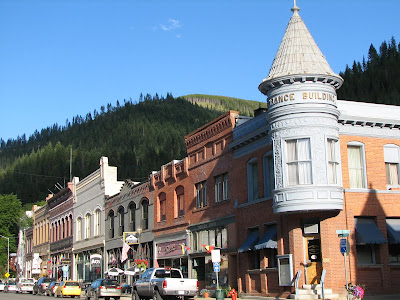One hundred years ago, Wallace, Idaho, nearly disappeared from the map, and what a tragedy that might have been. The town, set in a narrow, wooded canyon surrounded by the Bitterroot Mountains, is the hub of one of the richest mining districts in the world. Over one billion ounces of silver and other precious metals have been extracted from the nearby area earning it the moniker, Silver Capital of the World. It has an amazing collection of late 19th century buildings and the entire town is listed on the National Register of Historic Places. Like many western mining towns, Wallace has a rowdy past and quirky reputation, but has also experienced some rather spectacular disasters.
After gold and silver were discovered in the region, fortune seekers and miners arrived in droves, and by 1886, Wallace was a thriving community. In 1890, a fire destroyed the entire downtown center. The community rebuilt the town using bricks and cast iron instead of wood so it could survive any future fires. That was a wise decision for in 1910, an epic forest fire swept through the area. In 36 hours, the conflagration, known as the Big Burn, ravaged an area the size of Connecticut, taking 87 lives along the way. Over one-third of Wallace was destroyed.
Throughout the 1890s, Wallace was the scene of violent labor wars between the newly-formed unions and the mining companies. The U.S. Army was called upon to quell the fighting and before things settled down, a train full of dynamite blew up the Bunker Hill Mine, over one thousand miners were held in a makeshift prison, the governor of Idaho was assassinated, and it all ended with a Clarence Darrow trial in Boise. Then, there were several major floods and a dreadful mine accident where over 90 miners lost their lives. No wonder Wallace was chosen as the locale for the disaster film, Dante’s Peak.
Despite its small size, Wallace is home to a trio of excellent museums. The Wallace District Mining Museum, located in an old bakery building in the downtown area, tells the history of the mining industry from the 1880s to present time. There are mine models, drilling equipment, lighting devices, tools and all sorts of guy-stuff related to mining, but of special interest is the exhibit on the labor wars of the late 19th century. The museum is the home of “Old Blinky,” the last stop light on Interstate 90 between Boston and Seattle. Because of the confines of the canyon location, many historic buildings needed to be razed to complete construction of the interstate highway through town. To save them, folks had the entire town put on the National Register, thus ensuring protection from the wrecking ball. The freeway now by-passes town on an elevated viaduct.
The Northern Pacific Railroad Museum is in the attractive town depot. While it’s been 30 years since the last train ran through Wallace, the depot serves as a reminder of a time when the railroad played an important role in the development of the region. The building was constructed in 1901 in the chateau-style architecture so popular in Canada at that time. The bricks were imported from China and originally destined for a luxury hotel in Tacoma that never materialized. Inside, is a museum that should please any railroad buff with all sorts of Northern Pacific memorabilia.The third museum in town is quite unusual, featuring a tasteful glimpse at the world’s “oldest profession.” For years, a number of brothels operated in Wallace’s red-light district and, while prostitution was illegal in the state of Idaho, law enforcement looked the other way. The Oasis Bordello, opened in 1895, served the community until 1988 when it abruptly closed its doors. The occupants obviously left in a big hurry, taking little with them. The rooms upstairs are as they left them with personal items lying about and dirty dishes in the kitchen sink.
Other things to do in Wallace include a trolley tour through the Sierra Silver Mine; a bicycle ride along the Route of the Hiawatha, considered the best of all the rails-to-trails rides in the country; and, most importantly, indulging in a huckleberry milkshake at the Red Light Garage diner.




No comments:
Post a Comment